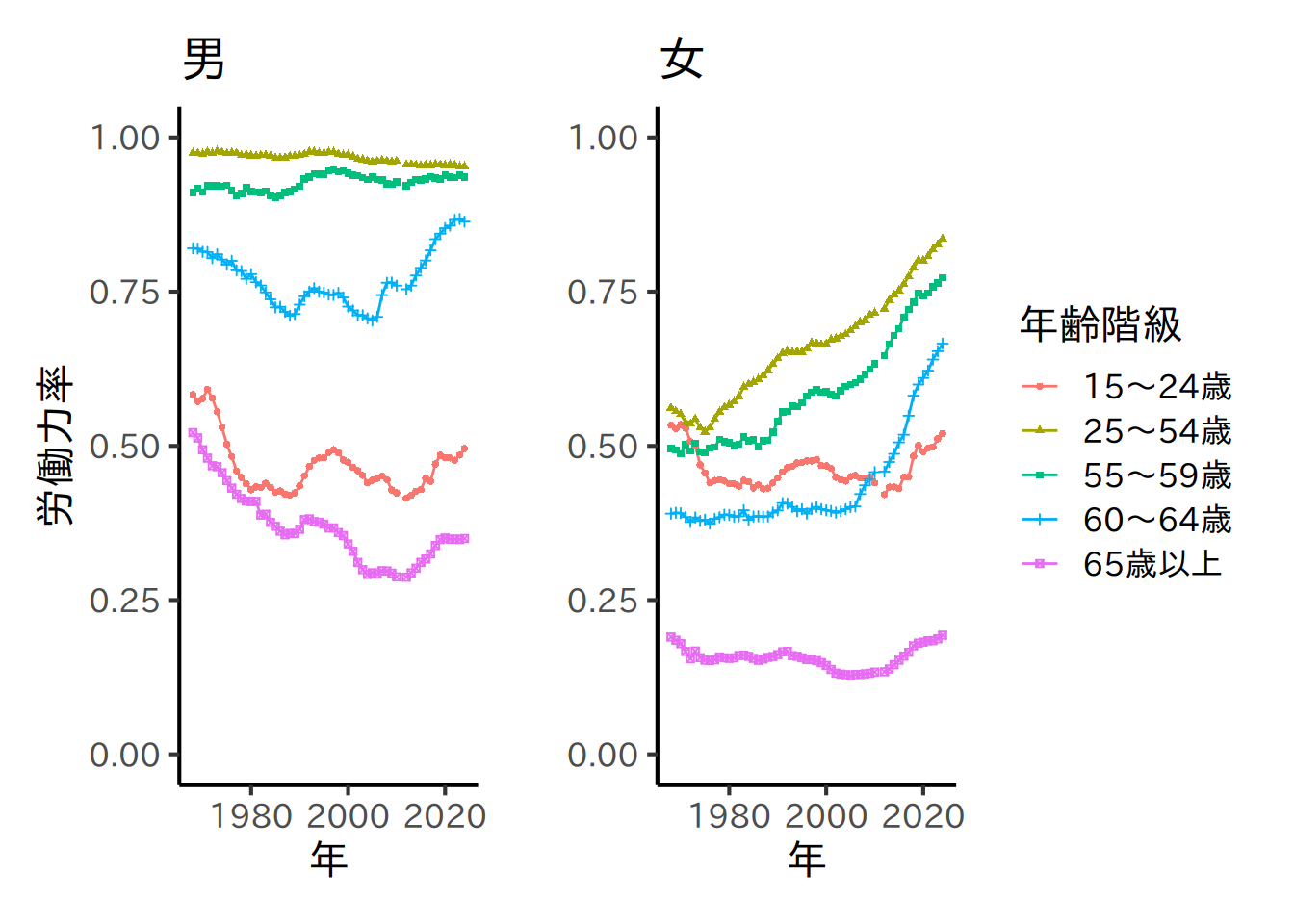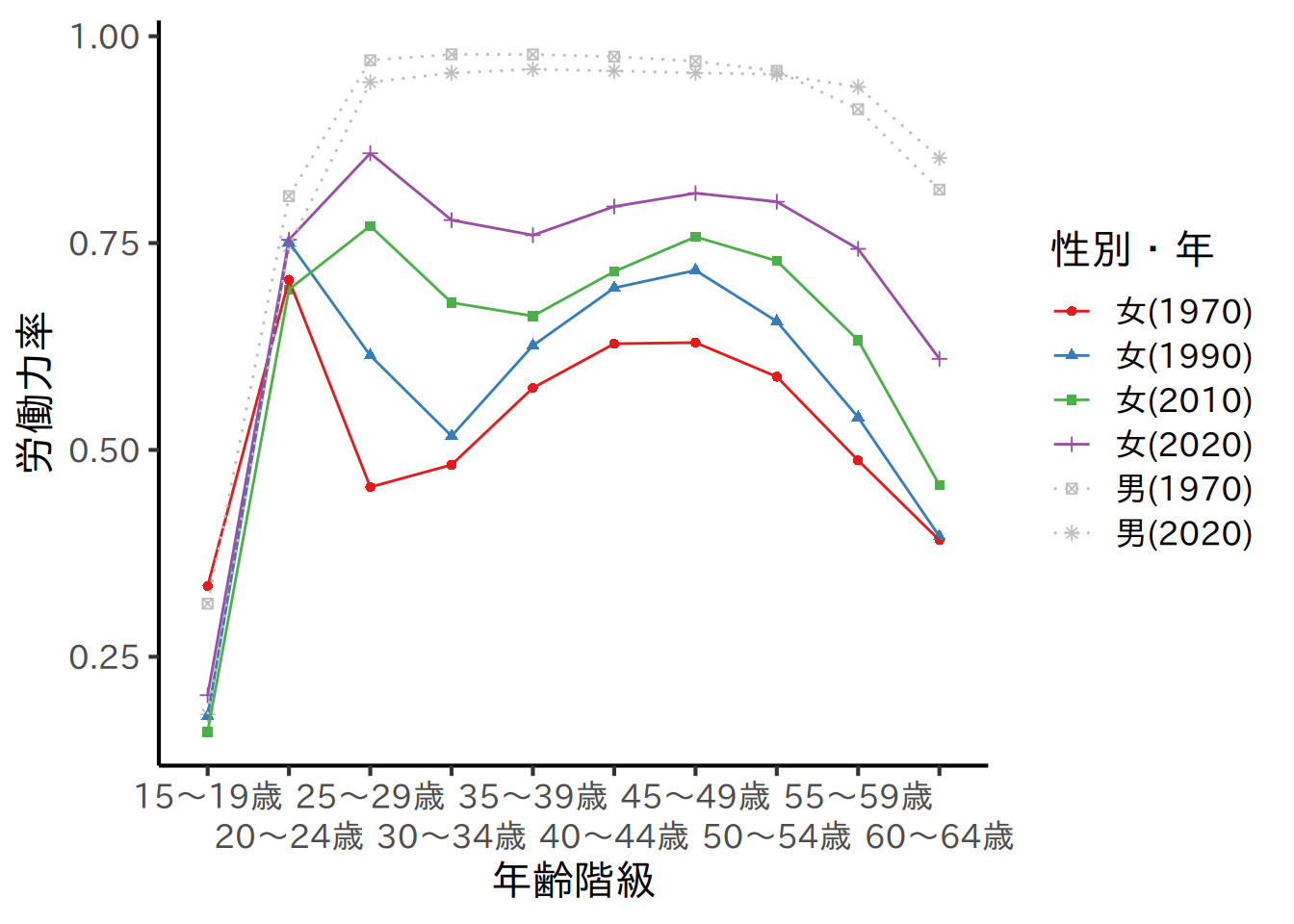library(tidyverse)
library(estatapi)
library(readxl)
library(RColorBrewer)
library(patchwork)
# e-statのappIDが必要
# 以下のページで利用申請(無料)をすればだれでも入手できる
# https://www.e-stat.go.jp/api/
# appID = "入手したappIDをここに設定(行頭の#を外す)"
# グラフのテーマ
theme_set(theme_classic(base_family = "IPAexGothic", base_size = 16))
# ファイルのダウンロード先ディレクトリ作成
dir.create("files", showWarnings = FALSE)
# e-statからファイルのダウンロード
# 人口推計 長期時系列データ 我が国の推計人口(大正9年~平成12年)
download.file(
"https://www.e-stat.go.jp/stat-search/file-download?statInfId=000000090261&fileKind=0",
destfile = "files/pop_estimate1920-2000.xlsx",
method = "curl"
)
# 人口推計 長期時系列データ(平成12年~令和2年)
download.file(
"https://www.e-stat.go.jp/stat-search/file-download?statInfId=000013168601&fileKind=4",
destfile = "files/pop_estimate2000-2020.xlsx",
method = "curl"
)
# 総人口データの結合
pop_1 <- read_excel(
"files/pop_estimate1920-2000.xlsx",
range = "D11:D90",
col_names = FALSE
)
pop_2 <- read_excel(
"files/pop_estimate2000-2020.xlsx",
sheet = 1,
range = "D11:D25",
col_names = FALSE
)
pop_3 <- read_excel(
"files/pop_estimate2000-2020.xlsx",
sheet = 2,
range = "C11:C15",
col_names = FALSE
)
pop_4 <- estat_getStatsData(
appId = appID,
statsDataId = "0003448228", # 人口推計 各年10月1日現在人口 令和2年国勢調査基準 統計表 表番号001
cdCat01 = "001", # 男女計
cdCat02 = "001", # 総人口
cdCat03 = "01000" # 総数
) |>
rename(...1 = value) |>
select(...1)
population <- cbind(
seq(1920, 2019 + nrow(pop_4), 1),
rbind(pop_1, pop_2, pop_3, pop_4) / 10,
"総人口"
)
colnames(population) <- c("year", "value", "category")
# 労働力調査 基本集計 全都道府県 年次 表番号1-1-5
labor_force <- estat_getStatsData(
appId = appID,
statsDataId = "0002060047",
cdCat01 = "000", # 全産業
cdCat03 = c("00", "01", "08"), # 15歳以上人口,労働力人口,完全失業者
cdArea = "00000" # 全国
) |>
mutate(year = as.numeric(time_code) / 1000000) |>
select(year, `性別`, `就業状態`, `年齢階級`, `value`)
# 総人口と労働力人口の推移
population_laborforce <- rbind(
labor_force |>
mutate(
category = factor(
case_when(
`就業状態` == "15歳以上人口" & `年齢階級` == "15歳以上" ~ "15歳以上人口",
`就業状態` == "15歳以上人口" & `年齢階級` == "15~64歳" ~ "生産年齢人口",
`就業状態` == "労働力人口" & `年齢階級` == "15~64歳" ~ "労働力人口",
TRUE ~ ""
),
levels = c(
"総人口", "15歳以上人口",
"生産年齢人口", "労働力人口"
)
)
) |>
filter(`性別` == "総数" & category != "") |>
select(year, value, category),
population
)
# グラフ作成
graph_population_laborforce <- population_laborforce |>
filter(year >= 1968) |>
ggplot(
aes(
x = year,
y = value,
color = category,
shape = category
)
) +
geom_line() +
geom_point(size = 2) +
scale_color_discrete(name = "") +
scale_shape_discrete(name = "") +
labs(x = "年", y = "人口(万人)")
plot(graph_population_laborforce)
# 年齢階級別労働力率
# データ整理
lf_by_age <- labor_force |>
filter(year >= 1968) |>
pivot_wider(names_from = `年齢階級`) |>
mutate(`25~54歳` = `25~34歳` + `35~44歳` + `45~54歳`) |> # 25~54歳までをまとめる
pivot_longer(
- c("year", "性別", "就業状態"),
names_to = "年齢階級"
) |>
pivot_wider(
names_from = `就業状態`
) |>
mutate(
participation_rate = `労働力人口` / `15歳以上人口`,
unemployment_rate = `完全失業者` / `労働力人口`
)
# グラフ作成
age_groups <- c("15~24歳", "25~54歳", "55~59歳", "60~64歳", "65歳以上")
graph_male_age <- lf_by_age |>
filter(`性別` == "男" & `年齢階級` %in% age_groups) |>
ggplot(
aes(
x = year,
y = participation_rate,
color = `年齢階級`,
shape = `年齢階級`
)
) +
geom_line() +
geom_point(size = 1) +
ylim(0, 1) +
labs(
title = "男",
x = "年",
y = "労働力率"
) +
theme(legend.position = "none")
graph_female_age <- lf_by_age |>
filter(`性別` == "女" & `年齢階級` %in% age_groups) |>
ggplot(
aes(
x = year,
y = participation_rate,
color = `年齢階級`,
shape = `年齢階級`
)
) +
geom_line() +
geom_point(size = 1) +
ylim(0, 1) +
labs(
title = "女",
x = "年",
y = ""
)
plot(graph_male_age + graph_female_age)
# M字カーブ
# データ整理
years <- c(1970, 1990, 2010, 2020)
age_groups <- c(
"15~19歳",
"20~24歳",
"25~29歳",
"30~34歳",
"35~39歳",
"40~44歳",
"45~49歳",
"50~54歳",
"55~59歳",
"60~64歳"
)
m_curve <- lf_by_age |>
filter(
(`性別` == "女" & year %in% years & `年齢階級` %in% age_groups) | # 女性
(`性別` == "男" & year %in% c(years[1], years[length(years)]) &
`年齢階級` %in% age_groups) # 男性は最初と最後の年のみ
) |>
mutate(`性別・年` = paste(`性別`, "(", year, ")", sep = ""))
# グラフ作成
graph_m_curve <- m_curve |>
ggplot(
aes(
x = `年齢階級`,
y = participation_rate,
color = `性別・年`,
linetype = `性別・年`,
shape = `性別・年`,
group = `性別・年`
)
) +
geom_point() +
geom_line() +
scale_color_manual(
values = c(brewer.pal(4, "Set1"), "grey", "grey")
) +
scale_x_discrete(
guide = guide_axis(n.dodge = 2)
) +
scale_linetype_manual(
values = c(
"solid",
"solid",
"solid",
"solid",
"dotted",
"dotted"
)
) +
labs(y = "労働力率")
plot(graph_m_curve)


